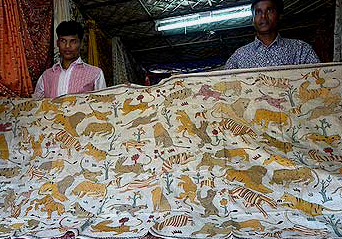 Embroidery of India includes dozens of regional embroidery styles varying by different regions. The Indian embroidery has a wide variety due to the use of different materials. The various types of Indian embroidery contains different aspects of regional specialty like Gold embroidery of Jaipur, known as `Gota-Work`, Kantha embroidery of West Bengal, Karchobi embroidery, Kashida embroidery, Kasuti embroidery, Kathi embroidery, Patti Ka Kaam etc.
Embroidery of India includes dozens of regional embroidery styles varying by different regions. The Indian embroidery has a wide variety due to the use of different materials. The various types of Indian embroidery contains different aspects of regional specialty like Gold embroidery of Jaipur, known as `Gota-Work`, Kantha embroidery of West Bengal, Karchobi embroidery, Kashida embroidery, Kasuti embroidery, Kathi embroidery, Patti Ka Kaam etc.
Zardozi Embroidery
Zari is gold, and Zardozi embroidery is the glitteringly ornate, heavily encrusted gold thread work practiced in Rajasthan, Uttar Pradesh, Kashmir and Delhi. It is however synthetic or `tested` zari embroidery. Metal ingots are melted and pressed through perforated steel sheets, to be converted into wires. They are then hammered to the required thinness. Plain wire is called Badla, and round one is called Kasav. Smaller spangles are called Sitara, and tiny dots made of Badla are called Mukaish.
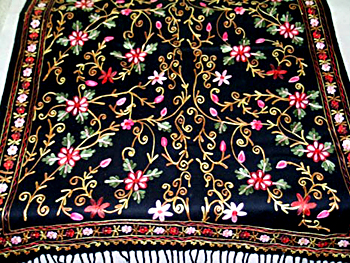 Kashmiri Embroidery
Kashmiri Embroidery
Kashmiri embroidery or Kashida is colourful. The workers often draw inspiration from the beautiful nature around. The colours are taken of flowers, creepers and chinar leaves, mango etc. The whole thing is created using one or two embroidery stitch styles. Kashmiri Embroidery is done on canvas base material with crystal threads. Pashmina and leather threads are also used in Kashmiri Embroidery. Sozni embroidery or Dorukha is often done so articulately that the motif appears on both sides of the shawl each side having a different colour. There is no wrong side. The same design is produced in different colours on both sides. Kashmir is also known for Phirans (woollen kurtas) and Namdahs (woollen rugs) with big floral embroidery having cheerful colours on them.
Papier Mache Embroidery
Another type of needle embroidery is known as Papier Mache embroidery because flowers and leaves are worked in satin stitch in bright colours. This is done either in broad panels on either side of the breadth of a shawl, or covering the entire surface of a stole.
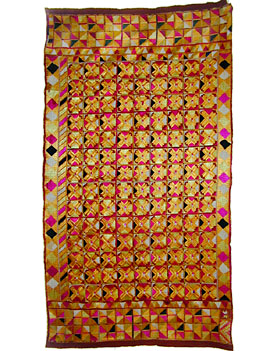 Gota Work
Gota Work
Akin to Applique, Gota work involves placing woven gold cloth onto other fabric to create different surface textures. Kinari, or edging, as the word means, is the fringed or tasselled border decoration. The art is predominantly practiced by Muslim craftsmen.
Phulkari Embroidery
Embroidered extensively in Haryana and Punjab, the Phulkari shawl is a beautiful piece of clothing. Birds, flowers and human figures are normally embroidered on red or orange khaddar (coarse cotton cloth made of handspun yarn).The embroidery is usually done with silk or satin thread, in both a vertical and horizontal pattern so that when the phulkari is finally ready, the play of light on its shiny surface lends it magnificent beauty.
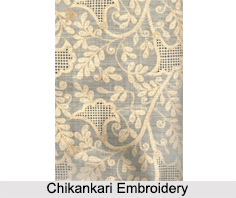 Chamba Embroidery
Chamba Embroidery
Richly embroidered with red and orange colours on silk scarves, Chamba embroidery is beautiful in design. They often depict scenes from the Mahabharata, the Ramayana and the Raslila of Radha and Lord Krishna. The embroidery is done with silk yarn on tussar (silk) or fine cotton.
Chikankari Embroidery
Chikankari of Lucknow in Uttar Pradesh is well known for white thread embroidery on white or coloured cotton. Intricate and complex, this work is similar to what is commonly known as Shadow work. The beauty of the embroidery comes on fine muslin cloth, where one can see the stitches forming lace-like patterns on the underside.
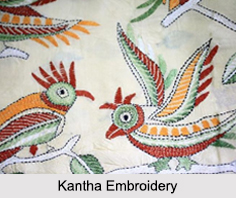
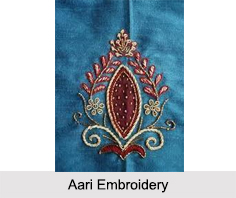 Kasuti Embroidery
Kasuti Embroidery
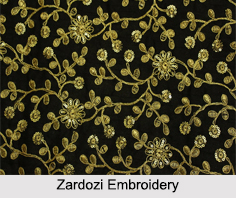 Other Embroideries of India
Other Embroideries of India



















